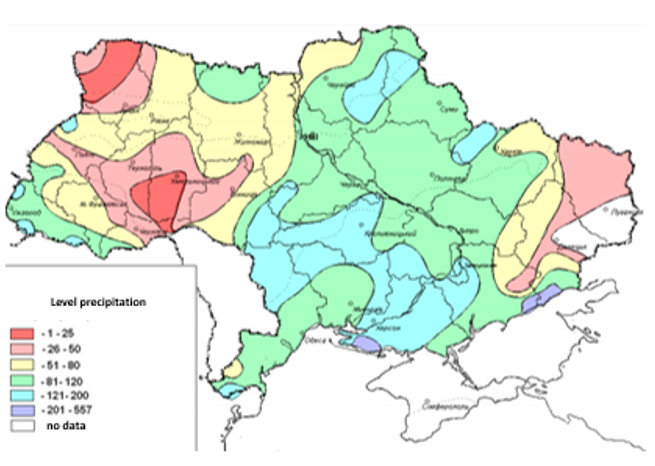In the first and second ten-day periods of April in Ukraine there was cool, on some days cold weather with an uneven distribution of precipitation. The average regional ten-day air temperature almost throughout the country turned out to be close to normal, in the Volyn, Zhytomyr, Chernigiv, Sumy, Kharkiv regions – by 1.1-1.5 °С above the norm, in the Luhansk – by 2.2 °С higher, in the Transcarpathia it was 1.3 °C below normal and ranged from 6.6 °C in the west to 11.1 °C in the east of the country. The maximum air temperature on the warmest days increased to 17-21 °C, in the Transcarpathian, Lviv, Khmelnytsky, Vinnytsya, Sumy, Kharkiv and Luhansk regions – to 22-26 °C. The minimum air temperature on the coldest nights dropped to 0 °С-minus 5 °С. Precipitation of various amounts and intensity was noted throughout the country for 1-4 days in the form of rain, snow and sleet. In the Volyn and Rivne regions – up to 1 °С.
Precipitation of varying intensity, in places with thunderstorms, in the western regions – sometimes with wet snow was observed for 1-6 days.
In most regions, their average regional number for a ten-day period was 121-192% of the norm (16-25 mm), in the Zaporizhzhya and Volyn regions – 220-250% of the ten-day norm (22-30 mm). In the Mykolayiv, Kirovohrad, Poltava and Zhytomyr regions the amount of precipitation was close to the ten-day norm and amounted to 12-19 mm. In the Cherkasy, Vinnytsya, Khmelnytsky, Ternopil, Ivano-Frankivsk and Chernivtsi regions their number was 52-80% of the ten-day norm (10-13 mm). In many areas of the Zaporozhzhya, Volyn, in some areas of Odesa, Dnipropetrovsk, Cherkasy, Kyiv, Kharkiv and Luhansk regions, the daily maximum precipitation reached 20-33mm (1.5-2.5 ten-day norms).

Due to moderate heat accumulation, low daytime air temperatures and the presence of frosts, the growth and development of agricultural, fruit and berry crops took place somewhat slower, but there was no significant lag behind the average long-term periods in the phase development of the main crops. In the southern and western regions, on winter wheat crops, almost a week earlier than usual, the formation of the lower node of the straw began, and the formation of reproductive organs began. Agrometeorological conditions for rooting, engraftment and spring vegetation of winter crops remained quite favorable. According to the spring survey of crops by hydrometeorological organizations, most winter crops were in good condition with yield potential above average. Soil moistening is good and optimal.